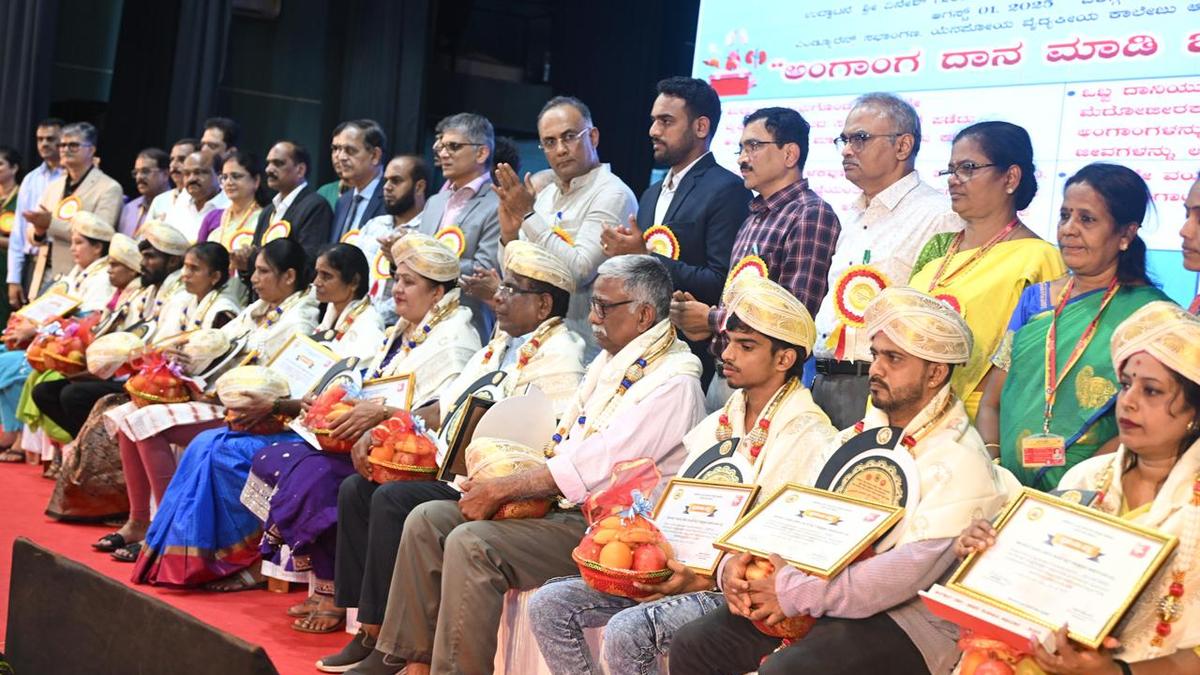Kalaburagi district in Karnataka has emerged as a top performer in the timely delivery of citizen services through Nadakacheri centres, significantly outpacing other districts in the state. This achievement highlights the district’s remarkable strides in e-governance and public service availability, particularly in rural areas.
Kalaburagi’s impressive performance is rooted not only in administrative efficiency but also in its deep understanding of the local demographic and socio-economic profile. The district administration has tailored service delivery mechanisms to address the specific needs of underserved communities, ensuring equitable access across diverse population groups.
Training and capacity-building for the staff at Nadakacheri centres have been pivotal in maintaining high service standards. The government regularly organizes workshops and skill development programs for the personnel managing these centres, enabling them to handle citizen requests accurately and within stipulated timeframes.
Another important factor contributing to the success is the proactive communication strategy adopted by the district. Information about available services, required documents, and processing timelines is widely disseminated through local media, community meetings, and digital platforms, reducing ambiguity and empowering citizens to approach the centres prepared.
The digitization of records and application processing has drastically reduced the scope for manual errors and corruption. By maintaining a transparent trail of service requests and approvals, Kalaburagi’s Nadakacheri centres have gained public confidence as trustworthy gateways to government benefits and certifications.
Kalaburagi’s approach also emphasizes the integration of grievance redressal mechanisms within the Nadakacheri framework. Citizens are encouraged to report delays or deficiencies, and a responsive system ensures these concerns are promptly addressed, thereby fostering accountability and continual improvement.
The vast network of Nadakacheri centres covers nearly every hobli in Kalaburagi, ensuring geographical inclusivity. This reduces the travel burden on rural citizens who previously had to visit far-off government offices, thus saving time and transportation costs and encouraging more frequent engagement with government services.
About Nadakacheri Centres and Their Services
Nadakacheri centres, officially known as Atalji Janasnehi Kendras, were launched statewide on December 25, 2012, to facilitate the transparent, reliable, and affordable electronic delivery of government services at the hobli (administrative cluster) level. Originally started as the “Nemmadi” project in 2006, these centres provide around 40 essential services, including caste and income certificates, land-related services, social security pensions, and more. The integration of backend computerization and monitoring has enabled real-time tracking and reduced delays in service delivery.
Kalaburagi’s focus on inclusivity extends beyond geographic coverage to cater effectively to vulnerable groups such as women, elderly citizens, and persons with disabilities. Special provisions and awareness campaigns ensure that these groups can access Nadakacheri services without facing discrimination or obstacles, promoting social equity through governance.
The district administration’s emphasis on data-driven decision-making has enabled Kalaburagi to fine-tune its service delivery mechanisms. By analyzing metrics such as average processing times, application rejection rates, and citizen feedback scores, administrators identify bottlenecks and implement corrective actions swiftly to maintain high efficiency.
Coordination between Nadakacheri centres and various government departments is seamless in Kalaburagi. For instance, close liaison with the Revenue Department, Rural Development, and Social Welfare departments ensures that documents and benefits requiring cross-departmental input are processed quickly and accurately, reducing inter-departmental delays.
The use of local language interfaces and multilingual support at Nadakacheri centres has made the entire service process more accessible to the largely rural population of Kalaburagi. This attention to linguistic inclusiveness has helped increase citizen engagement and the successful submission of applications.
Kalaburagi’s Nadakacheri centres actively participate in awareness drives related to government welfare schemes beyond just certification services. From health scheme registrations to educational scholarships, these centres serve as crucial points for enrollment and dissemination of information, enhancing the district’s overall socio-economic welfare.
Regular audits and social accountability exercises are conducted by both independent agencies and government bodies to ensure the transparency and integrity of Nadakacheri centres’ operations. Such scrutiny reinforces citizen confidence and helps uphold high standards of service delivery without corruption.
The district has embraced innovations like kiosks and service counters at marketplaces and transport hubs to further reduce access barriers. These outreach efforts bring government services closer to daily life settings, making it easier for working individuals and those with mobility challenges to avail themselves of services.
Kalaburagi’s strategy includes continuous digital literacy enhancement programs for residents, especially targeting women’s self-help groups and youth clubs. These programs empower citizens to not only use Nadakacheri services independently but also assist others in their communities, creating a multiplier effect.
The Nadakacheri system in Kalaburagi has also become a model for disaster resilience in governance. During adverse events such as floods or pandemics, these centres have adapted by introducing remote application processing and extended timelines, ensuring continuity of critical services when physical access is disrupted.
A strong culture of innovation and feedback is fostered among the Nadakacheri staff in Kalaburagi. Regular meetings, suggestion platforms, and incentive mechanisms encourage frontline workers to propose improvements and address grassroots challenges, making the system dynamic and citizen-responsive.


Key Factors Behind Kalaburagi’s Success
-
Comprehensive Coverage and Governance: Kalaburagi has numerous Nadakacheri centres linked closely with district administration, with strong leadership from the Deputy Commissioner ensuring accountability.
-
Advanced Technology Utilization: The district leverages e-governance platforms to streamline processes, minimizing paperwork and cutting processing times drastically.
-
Focus on Rural Inclusion: Serving a historically backward region, Kalaburagi extends essential services to remote areas, making government certificates and benefits accessible beyond urban centres.
-
Strong Government Backing: Development initiatives by the state government, including infrastructure and industrial investments, indirectly bolster Nadakacheri operations.
-
Transparency and Monitoring: Rigorous oversight by the Atalji Janasnehi Directorate helps Kalaburagi maintain timely service delivery and transparency.
-
Synergy with Other Government Schemes: Effective Nadakacheri services complement other state initiatives such as startup and smart city programs, enhancing citizen satisfaction.
-
Citizen-Centric Approach: Uniform, affordable, and accessible services have built high trust and frequent usage among Kalaburagi residents.
Challenges and Future Outlook
Despite the progress, issues like infrastructure upgrades and improving digital literacy in rural areas remain ongoing priorities that the government is actively addressing.

Conclusion: A Model for E-Governance Excellence
Kalaburagi’s leading position in delivering timely services through Nadakacheri centres exemplifies how dedicated governance, technology integration, and inclusive outreach can boost public service effectiveness at the grassroots. Other districts can draw valuable lessons from its success story.
Local self-governments and Panchayati Raj institutions actively collaborate with Nadakacheri centres to facilitate service delivery. This collaborative governance model strengthens community participation and helps identify emerging needs, allowing the centres to adapt dynamically to changing demands.
Kalaburagi’s commitment to leveraging emerging technologies such as mobile apps and SMS services complements the physical centres by providing multiple channels for citizens to seek assistance or track their applications, creating a seamless interface between the government and residents.
Significant investment in infrastructure, including well-equipped premises with adequate waiting areas, computer systems, and dedicated helpdesks, has enhanced the overall citizen experience at Nadakacheri centres. The government’s focus on creating a user-friendly environment reflects in higher footfall and positive user feedback.
Kalaburagi’s robust approach to capacity building extends beyond formal training sessions to include field-level mentorship and peer learning among Nadakacheri centre staff. Experienced employees regularly guide new recruits on addressing complex customer queries, handling digital transactions, and maintaining patience and empathy in service delivery. This on-the-job learning fosters a culture of professionalism and continuous improvement, ensuring that staff remain motivated and competent in adapting to evolving administrative procedures.
The district has also prioritized incorporating feedback from citizens through structured channels such as suggestion boxes, helpline numbers, and periodic town hall meetings. This two-way communication system allows residents to report service lapses or suggest new service areas, which are then reviewed by district administrators. By actively listening to and acting on citizen input, Kalaburagi strengthens trust in government institutions and promotes a participatory governance model that values grassroots voices.
Infrastructure development for Nadakacheri centres in Kalaburagi includes deploying reliable internet connectivity even in the remotest hoblis, overcoming one of the major barriers to digital governance. Collaboration with telecom providers and the use of alternative technologies such as satellite internet have played critical roles in this endeavor. Ensuring consistent connectivity has eliminated delays caused by technical issues and has enabled real-time status updates of applications, directly benefiting citizen satisfaction.
Kalaburagi’s administration has also innovated by integrating Nadakacheri services with mobile outreach camps that periodically visit remote villages. These camps bring documentation and verification services closer to villagers, reducing the need for travel and helping particularly vulnerable groups such as the elderly and disabled. The data collected during camps is seamlessly synced with Nadakacheri’s central systems, maintaining efficiency without sacrificing accessibility.
The district government’s proactive approach includes forging partnerships with local NGOs, educational institutions, and community leaders to spread awareness about Nadakacheri services and help bridge the digital divide. These collaborations target women’s groups, youth clusters, and marginalized communities, thereby empowering a broad spectrum of the population to confidently navigate and utilize government services, which contributes to more inclusive governance.
Finally, Kalaburagi is exploring the use of advanced analytics and artificial intelligence to predict service demand patterns and optimize resource allocation at Nadakacheri centres. By forecasting peak application periods and potential service bottlenecks, the district aims to dynamically adjust staffing and streamline workflows, thus maintaining prompt service delivery. This forward-looking strategy positions Kalaburagi not only as a current leader in e-governance but also as a pioneer in technologically augmented public administration in India.
Looking ahead, Kalaburagi aims to pilot innovative solutions like biometric authentication and blockchain for enhanced security and efficiency in service delivery. Incorporating citizen feedback and evolving technology platforms will likely sustain and build upon the district’s current leadership in digital governance.
Follow: Karnataka Government
Also read: Home | Channel 6 Network – Latest News, Breaking Updates: Politics, Business, Tech & More

